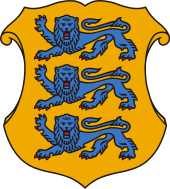Estonian Sovereignty Declaration
The Estonian Sovereignty Declaration (Estonian: suveräänsusdeklaratsioon), fully: Declaration on the Sovereignty of the Estonian SSR (Deklaratsioon Eesti NSV suveräänsusest), was issued on November 16, 1988[1] during the Singing Revolution in Estonia. The declaration asserted Estonia's sovereignty and the supremacy of the Estonian laws over the laws of the Soviet Union.[2] Estonia's parliament also laid claim to the republic's natural resources: land, inland waters, forests, mineral deposits and to the means of industrial production, agriculture, construction, state banks, transportation, municipal services, etc. in the territory of Estonia's borders.[2] November 16 is now celebrated annually as the "Day of Declaration of Sovereignty" ("Suveräänsuse deklareerimise päev").
Overview
Estonia gained independence in the aftermath of World War I and Estonian War of Independence (1918–1920). In 1940 as a consequence of the German–Soviet Nonaggression Pact and its Secret Additional Protocol of August 1939 Estonia was occupied and annexed by the Soviet Union.
The majority of Western nations refused to recognize the incorporation of Estonia de jure by the Soviet Union and only recognized the government of the Estonian SSR de facto or not at all.[3][4] Such countries recognized Estonian, Latvian and Lithuanian diplomats and consuls who still functioned in the name of their former governments. These aging diplomats persisted in this anomalous situation until the ultimate restoration of Baltic independence.[5]
In the 1980s new policies of Perestroika and Glasnost were introduced and political repression in the Soviet Union came to an end. As a result, during the 1991 Soviet coup d'état attempt a 20 August 1991 declaration proclaimed the reestablishment of the independent Estonian republic almost three years after the declaration was made, becoming the last of the Baltic republics to declare the reestablishment of independence (after Lithuania and Latvia in 1990).[6] On September 6, 1991, the Soviet Union recognized the independence of Estonia and the country was admitted to the UN on September 17.[7]
After more than three years of negotiations, on August 31, 1994, the armed forces of Russia withdrew from Estonia. The Russian Federation officially ended its military presence in Estonia after it relinquished control of the nuclear reactor facilities in Paldiski in September 1995. Estonia joined the European Union in May 2004, shortly after it became a member of NATO, and later joined the Organisation for Economic Co-operation and Development in 2010.
See also
- Estonian Declaration of Independence
- Estonian restoration of Independence
- On the Restoration of Independence of the Republic of Latvia
- Act of the Re-Establishment of the State of Lithuania
References
- Frankowski, Stanisław; Paul B. Stephan (1995). Legal reform in post-communist Europe. Martinus Nijhoff Publishers. p. 84. ISBN 0-7923-3218-0.
- Walker, Edward (2003). Dissolution. Rowman & Littlefield. p. 63. ISBN 0-7425-2453-1.
- Talmon, Stefan (2001). Recognition of Governments in International Law. Oxford University Press. p. 103. ISBN 978-0-19-826573-3.
- Aust, Anthony (2005). Handbook of International Law. Cambridge University Press. pp. 26. ISBN 0-521-82349-8.
- Diplomats Without a Country: Baltic Diplomacy, International Law, and the Cold War by James T. McHugh, James S. Pacy, Page 2. ISBN 0-313-31878-6
- Miljan, Toivo (2004). Historical Dictionary of Estonia. Scarecrow Press. ISBN 0-8108-4904-6.
- Europa Publications Limited (1999). Eastern Europe and the Commonwealth of Independent States 1999. p. 333. ISBN 1-85743-058-1.
